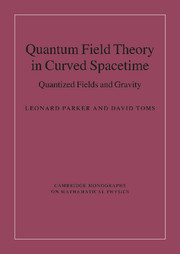Book contents
- Frontmatter
- Contents
- Preface
- Acknowledgments
- Conventions and notation
- 1 Quantum fields in Minkowski spacetime
- 2 Basics of quantum fields in curved spacetimes
- 3 Expectation values quadratic in fields
- 4 Particle creation by black holes
- 5 The one-loop effective action
- 6 The effective action: Non-gauge theories
- 7 The effective action: Gauge theories
- Appendix: Quantized Inflaton Perturbations
- References
- Index
5 - The one-loop effective action
Published online by Cambridge University Press: 25 January 2011
- Frontmatter
- Contents
- Preface
- Acknowledgments
- Conventions and notation
- 1 Quantum fields in Minkowski spacetime
- 2 Basics of quantum fields in curved spacetimes
- 3 Expectation values quadratic in fields
- 4 Particle creation by black holes
- 5 The one-loop effective action
- 6 The effective action: Non-gauge theories
- 7 The effective action: Gauge theories
- Appendix: Quantized Inflaton Perturbations
- References
- Index
Summary
Introduction
The main purpose of this chapter is to provide a link between the methods used in previous chapters and the more general methods contained in the following chapters necessary to study interacting fields. These more general methods, which may be applied to a wide class of theories, are based on the background field approach to the effective action. In this chapter we will concentrate on free fields, or fields interacting with background, or external, fields which are not quantized, as we did in the previous four chapters. We will defer the quantization of gauge fields to Chapter 7.
We begin this chapter by presenting the relation between the Schwinger action principle and the Feynman functional, or path, integral for the basic 〈out∣in〉 transition amplitude. Regularization of the one-loop effective action, which is simply related to the in-out transition amplitude, is discussed using a number of popular methods. (Cut-off, dimensional, and ς-function regularization are presented to complement our earlier treatment of regularization in Chapter 3.) Two explicit scalar field examples are given: the Schwinger effective Lagrangian for a constant electromagnetic field in flat Minkowski spacetime and the effective potential for a constant gauge field background in the spacetime ℝn−1 × S1. In these two cases it is possible to calculate an exact result for the effective action. The conformal anomaly for a scalar field, considered earlier in four spacetime dimensions, is analyzed from the Feynman path integral viewpoint.
- Type
- Chapter
- Information
- Quantum Field Theory in Curved SpacetimeQuantized Fields and Gravity, pp. 184 - 267Publisher: Cambridge University PressPrint publication year: 2009

